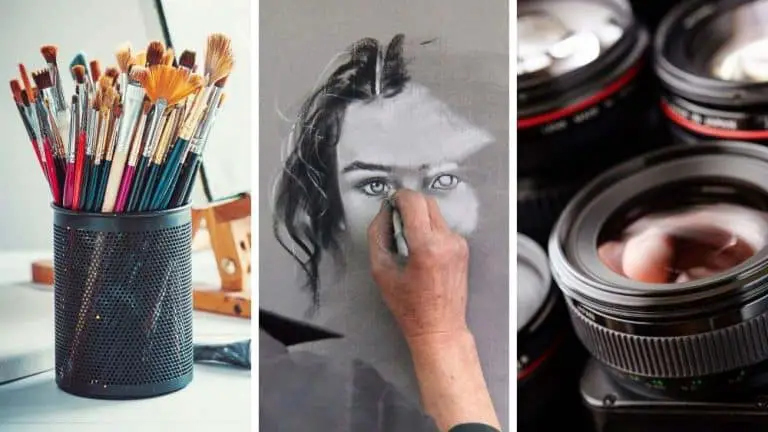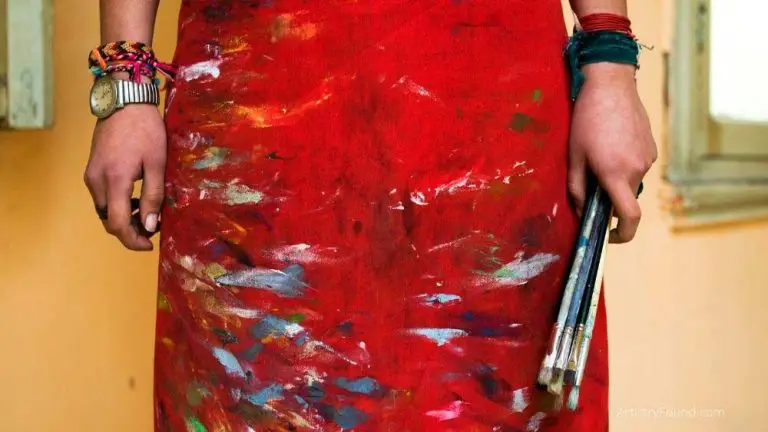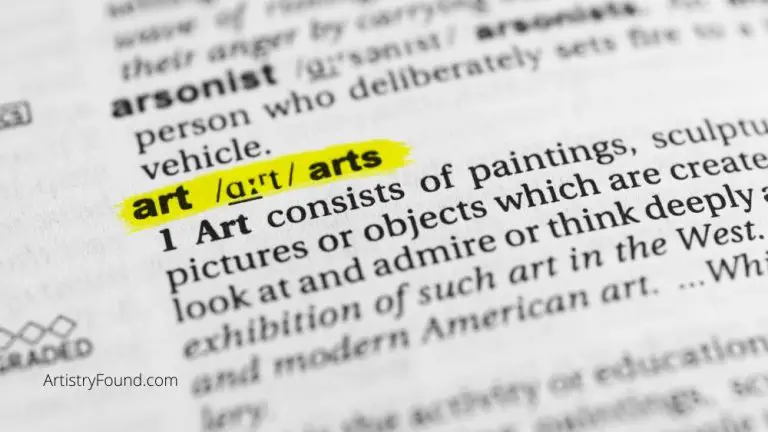What Makes Art Valuable? (Understanding Value in Art)
Have you ever wondered why one artist is paid tens of millions of dollars while another struggles to sell even a single piece of their artwork? If so, then you have come to the right place! In this article, I’ll discuss what makes art valuable and how to increase the value of your art.
However, first, you need to understand the fundamental concept of the art world. It is critical for everyone interested in taking their initial steps into the art industry.
Is pricing the only consideration in this concept? Is it a reflection of art’s symbolic meaning or the quality of its materials? Continue reading to learn more.
What Determines the Value of Art?

(This article may contain affiliate links and I may earn a commission if you make a purchase)
Photo by Alina Grubnyak on Unsplash
Being an artist is difficult, and appreciating art is an art form in itself. However, it still boggles the mind that something that appears to have been drawn by a small child could be worth several million dollars. What is the story behind the astronomical prices, and how are these artworks different from other works of art?
There are various ways to look at it, and if you’re curious about how to assess the true value of art or what makes it so exorbitantly expensive or worthless, keep reading.

Authenticity
The first feature that distinguishes a low-cost painting from a high-cost one is, of course, its authenticity. An original painting will always have higher values than a replica.
Artwork’s Provenance
Another huge determining factor in an artwork’s value is its provenance or the documented history of who it has previously belonged. In other words, who were the previous owners of the painting? An artwork that was once owned by a celebrity, a prominent collector, or came from perhaps a respected gallery, for example, would increase its value.
The condition also plays an important role in determining the value of art. If the art has undergone restoration or conservation work, or if it is in poor condition and requires extensive restoration, it can have a substantial impact on its value.
Intrinsic Value
When it comes to their art, artists don’t think about money. Money is only a little part of it; it’s more of a mirror of themselves in the vast wide world. Artists express their individual and artistic expression to a bigger audience through painting, sculpture, and performance arts.
The intrinsic (or underlying) is a pretty subjective emotional value tied to how a certain work of art makes the audience feel and what sensations it stimulates. Since emotional reactions can’t be kept or measured, it is difficult to assign them a value. Moreover, all of these factors are influenced by one’s ethnic background, education, and life experience and are relatively unaffected by the materials used.
Rise of Abstract and Modern Art
Camera technology ushered in a dramatic revolution in creative culture. Photography was initially used to document the world. Thus, traditional artists no longer believed that was their primary reason for creating art. As a result, art has lost its ability to skillfully depict the world.
In the modern era, art is about how you feel and how you represent yourself. This has been one of the major transformations in art culture, and it has had a significant impact on how the world values art.
Historical Significance
When it comes to judging the worth of art, know that the historical significance makes art valuable.
To begin, think about the artist’s work in terms of its historical significance within its genre. A painting by Claude Monet, for example, is more valuable than other recent impressionist works since Monet altered the narrative of art history and impressionism overall.
Art’s worth is also influenced by world history. After all, art is frequently a mirror of its time’s culture, and when it evolved into a commodity, it was influenced by political and historical changes, for example – The Mona Lisa painting.
The Artist’s Popularity & Background
The artist’s place in the art world is one of the most crucial factors to examine. Looking back through history, it’s simple to see that some artists were more influential than others, especially in the secondary market. This is due to a variety of causes, including being a leader and innovator.
If it’s a famous artist who wins prizes and is featured in exhibitions at prestigious galleries and museums, their artwork is more inclined to sell for a high price in the primary market.
If one of an artist’s paintings has been sold for a high price, other works by that artist will be considered valuable as well. And once an artist has established a brand, the sky is the limit in terms of assigning a monetary worth to their work.
The medium in which the painting is created also adds to its monetary value. Canvas works, for example, are expensive paintings. They are typically worth more than those on paper, and paintings are frequently worth more than sketches or prints.
The price an artist can command will be affected if they have an interesting backstory, such as early death. This is partly because if they died young and created less work, supply and demand would immediately kick in. But, it’s also because artists’ lives interest the audience, so any compelling story would help sell their work.
The Excitement of An Auction House
Art, like all other things, is evaluated in comparison to other works of art. The price of modern art is influenced by recent auction results. Billionaires — or, better still, their advisors – abound in Christie’s and Sotheby’s auction houses. A huge sum of money is on the line, and the whole thing is a whirlwind of activity.
Auctioneers are adept salespeople who help push prices higher and higher. They know when to raise the stakes dramatically and when to shift the scales slightly. They’re in charge of the show, with people bidding, and it’s their responsibility to ensure that the highest bidder gets a chance and that prices rise.
And they’re playing to the proper crowd because winning is a big part of the thrill for wealthy businessmen who frequently find themselves in auction houses.
Social Status
Many people regard art as a status thing and a stepping stone to a beautiful lifestyle. There are many art fairs, auctions, and gatherings with after-parties, and the rich and famous believe attending such events to be a status symbol.
Furthermore, they spend millions on art. It helps the wealthy make a public statement about their wealth and become the center of attention. With art, there’s also an element of exclusivity.
How Artists Can Increase The Value of Their Art

With the current global art market on the rise and living artists smashing auction records, what makes one artist more “valuable” than another?
Selling art has changed significantly over the past few decades. Works of art were commissioned in the Middle Ages and Renaissance periods, meaning that they were requested by a client and then manufactured to order. The buyer would discuss with the artist how he wanted the painting to be, the materials used, etc.
It wasn’t quite artistic freedom, but it did have its own benefits. You didn’t just paint anything and hope it sold as many artists do nowadays.
Below are ways that can make your art worth more money:
Establish an Artistic Brand
It takes more than a design, font style, or color to establish a brand. A brand is recognized because the consumer forms a personal bond with the company or product, or both. So how do you set yourself apart from the thousands of other artists that sell work online? It’s not as difficult as you may assume. All you need to do now is tell your tale.
- What is your personal narrative?
- What message are you attempting to convey through your artwork?
- What are your essential principles and morals?
- What are your sources of inspiration?
Your stories, morals, and fundamental values will draw in your target audience and increase brand exposure on the internet.
What If My Art Doesn’t Have Any Story?
Understand that every piece of art has a backstory. Remember that art comes from the depths of your soul or heart. It’s meaningful and not just a skill, practice, or thoughtless doodling. You are the protagonist of your own story.
When it comes to marketing your paintings or other artwork, you are the most important factor. Saying that your art lacks a story is like saying that you lack a story or that nothing is compelling about you or your work. You can’t possibly know what your art is about or how to express it if you don’t know who you are and what you believe in. And until you figure that out, you’re not going to get far.
Sign Your Artwork
Many artists are discovering how to sell their work online and earn money. I’ve discussed how telling your story and communicating your basic principles with your audience can boost the worth of your work. However, how can you encourage people to read your narrative if they have no idea who you are?
How can you be sure that people will recognize you as the artist behind the work they’re enjoying online? It’s not as difficult as you may believe. You only need to sign your artwork. Your work should have a signature that is constant across all of your artwork, whether it is legible or not. People will always know it’s yours this way.
Date Your Artwork
Don’t be fooled into thinking that collectors are exclusively interested in new items. People will want your previous work when you’re famous, and they’ll use it to explain your artistic progress. This will be valuable for both curators and art buyers as your career progresses.
Explain Your Art Piece
People want to know about your art, what it represents, expresses, or symbolizes, how it came to be, what’s going on in it, what inspired it, how you came up with the concept, and so on. There’s no need to get wordy, technical, or monotonous here.
You’ll need at least a one or two-sentence explanation of the art, a “way in” to understand or at least explore it, much like you’ll need a one or two-sentence explanation in a gallery or auction catalog. Allow collectors to communicate about your work with their friends by providing some information for them to talk about.
Number and Document Your Artwork
Set the edition size, never modify it, and number every piece in the edition consecutively if you’re a printmaker, digital artist, or you make multiples of any type. People who purchase multiples expect to receive a fixed edition size that will never vary.
Never alter the edition size or opt to print a new edition, no matter how successful it becomes. If you do so, you will betray the confidence of the original buyers, and, at worst, you will jeopardize the popularity and marketability of your art.
No matter how you look at it, maintaining accurate documentation of your art and art business is a great idea. This includes titles, dimensions, mediums, descriptions, images, videos, times, dates, sale prices or buyer names (where possible), and any published materials— online or in print— that are specifically linked to you and your art, such as criticisms, reviews, interviews, and so on.
Good documentation of your art career’s history and evolution is essential not just for you but also for coming generations, not to mention your reputation as an artist.
FAQs
What is Art Value?
A realistic evaluated value is based in part on what the work has already sold for or normally sells for not only in retail galleries, but also at auctions, secondary market websites, and other relevant venues, and it’s based on actual pricing data from previous sales.
Can Unknown Painters’ Artworks Be Valuable?
While original paintings command the highest prices, in some situations, a rare or customized print might be worth millions. A reproduction of a well-known artist’s painting is sometimes more valuable than a genuine painting by an unknown artist.
Is There Any Value in Unsigned Prints?
Prints are sometimes perceived as mass-produced replicas of well-known works of art that aren’t particularly significant or worthwhile investments. Nothing, however, could be further from the truth. Prints can be equally as valuable as any other piece of art, with some prints fetching seven or eight figures at auction.
Why Do Art Collectors Purchase Works of Art?
Aesthetics and a wish to dwell in the presence of art! The majority of online art consumers buy art to hang in their homes. Seventy-one percent of collectors polled stated that they purchase art to adorn their homes. This was the most often reported reason for buying art, even among investment-minded collectors.
What Is It That Makes Modern Art So Special?
Modernist art is defined by a rejection of traditional and conservative values or realistic renderings of subjects, as well as a richness of form (colors, shapes, and lines) with a focus on abstractions.
Tip
Every artist desires to sell their work and raise its worth. Selling art is an art form, and you’ll want to devote some time each week to improve your internet marketing skills. If you want to improve the worth of your artwork more quickly, you should learn how to become an expert in online marketing.
What Makes Art Valuable – Final Thoughts
The specific artist who created the work is highly valued by the market. It makes a significant difference whether the artist is undiscovered, emerging, or well-known. The value of an artwork is determined by the artist’s previous exhibitions, sales history, and level of experience.
In general, the higher the market price for an artist, the higher the demand for that artist. So hopefully, by now, you have a better idea of what makes art valuable.








